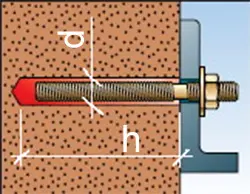Online Chemical Anchor Calculator
Our Chemical Anchor Calculator is designed to accurately compute chemical anchor consumption per hole in concrete structures based on the hole's diameter and depth, ensuring secure fastening.
To use the calculator, you need to:
- Select the volume of the chemical anchor cartridge (e.g., 300 or 400 ml);
- Specify the hole diameter;
- Set the hole depth.
Please note that the drilled hole’s diameter is typically 2–4 mm larger than the anchor’s nominal diameter. The recommended hole depth is approximately 10 times the anchor diameter for secure fastening in concrete structures.
If you are working with hollow substrates, the chemical anchor consumption may increase by up to 30%. In this case, check the "Hollow substrate" option for an accurate calculation.
Step-by-Step Guide for Chemical Anchor Installation
For hollow substrates:
- Drill the hole;
- Install the perforated sleeve;
- Fill the sleeve with chemical anchor;
- Insert the anchor rod;
- Allow it to fully cure.
For solid substrates:
- Drill the hole;
- Clean the hole of dust and debris;
- Fill the hole with chemical anchor until it reaches 2/3 of its volume;
- Insert the anchor rod with a twisting motion;
- Allow it to fully cure.
Our Chemical Anchor Calculator will help you save time and materials while ensuring precision and reliability in your fastening projects.
Our chemical anchor consumption calculator is designed for accurate calculations of anchor consumption based on the diameter and depth of the hole. It is an essential tool for concrete and other construction materials, helping you determine the required amount of anchor for one hole.
To use the calculator, you need to:
- Select the volume of the chemical anchor cartridge (e.g., 300 or 400 ml);
- Specify the hole diameter;
- Set the hole depth.
Please note that the hole diameter is usually 2-4 mm larger than the anchor's diameter. The recommended hole depth is 10 times the diameter of the anchor to ensure reliable fastening.
If you are working with hollow substrates, the chemical anchor consumption may increase by up to 30%. In this case, check the "Hollow substrate" option for accurate calculation.
Step-by-step guide for using chemical anchors
For hollow substrates:
- Drill the hole;
- Install the perforated sleeve;
- Fill the sleeve with chemical anchor;
- Insert the anchor rod;
- Allow it to fully cure.
For solid substrates:
- Drill the hole;
- Clean the hole of dust and debris;
- Fill the hole with chemical anchor to 2/3 of its volume;
- Insert the anchor rod with a twisting motion;
- Allow it to fully cure.
Our online chemical anchor consumption calculator will help you save time and materials, ensuring accuracy and reliability in your fastening projects.
